
Looking for How to Freeze Spinach, Kale, Swiss Chard. Collards and Other Greens in 2025? Scroll down this page and follow the links.
And if you bring home some fruit or vegetables and want to can, freeze, make
jam, salsa or pickles, see this
page for simple, reliable, illustrated canning, freezing or preserving
directions. There are plenty of other related resources, click on the resources dropdown above. If you are having a hard time
finding
canning lids, I've used these, and they're a great price &
ship in 2 days.
If you have questions or feedback, please let me know! There
are affiliate links on this page. Read our disclosure policy to learn more.
How to Freeze Spinach, Kale, Swiss Chard. Collards and Other Greens
How to Freeze Spinach, Kale, Swiss Chard. Collards and Other Greens
More photos and a PDF print version coming
If you like frozen greens in the winter, just imagine how good it would taste
if you had picked a bag yourself and then quickly froze it at home! It is
also one of the simplest ways to put up a vegetable for the winter. Here's how
to do it, complete instructions in easy steps and completely illustrated. The
greens will taste MUCH better than anything you've ever had from a store.
One note: Do not except them to be crisp. ANY frozen green becomes limp, and is best used in cooking, not salads. It's simply not possible to
freeze greens and retain the crispness. Freezing ruptures the cell walls.
Directions for Freezing Greens
Ingredients and Equipment
- fresh greens - any quantity. I figure one handful per serving.
- Vacuum food sealer or "ziploc" type freezer bags (the freezer bag
version is heavier and protects better against freezer burn.
|
- 1 Large pot of boiling water
- 2 large bowls, one filled with cold water and ice.
- 1 sharp knife
|
Instructions
Step 1 - Pick or select the greens!
This is the most important step! You need greens that are FRESH
and crisp. Limp, old greens will make nasty tasting frozen greens.
Select young, tender green leaves.
How many greens and where to get
them
You can grow your own, pick your own, or buy them at the grocery store.
About 14 pounds of greens makes 7 quart jars; or 9 pounds is needed per 9
pints. A bushel, which produces anywhere from 13 to 20 quarts, weighs 30
pounds. That works out to an average of 2 pounds of greens per finished
quart jar.
Start with fresh greens - as fresh as you can get.
Step 2 - Wash
the greens!
I'm sure you can figure out how to rinse the leaves in
plain cold water. I use a large bowl of cold water and a colander to
let them drain.
Step 3 -Hull the greens
Cut off any woody stems. or damaged pieces
Step 4 - Get the pots ready
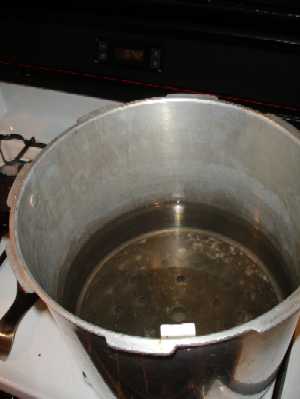 Get
the pot of boiling water ready (about 2/3 filled) and a LARGE bowl with
ice and cold water.
Get
the pot of boiling water ready (about 2/3 filled) and a LARGE bowl with
ice and cold water.
Step 5 - Blanch the greens.
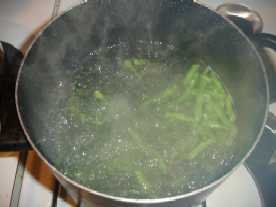 All
fruits and vegetables contain enzymes and bacteria
that, over time, break down the destroy nutrients and change the color,
flavor, and texture of food during frozen storage. greens requires a brief
heat treatment, called blanching, in boiling water or steam, to
destroy the enzymes before freezing. Blanching times for collards is 3
minutes and all other greens 2 minutes..
All
fruits and vegetables contain enzymes and bacteria
that, over time, break down the destroy nutrients and change the color,
flavor, and texture of food during frozen storage. greens requires a brief
heat treatment, called blanching, in boiling water or steam, to
destroy the enzymes before freezing. Blanching times for collards is 3
minutes and all other greens 2 minutes..
Begin counting the blanching time as soon as you place the
greens in the boiling water. Cover the kettle and boil at a high
temperature for the required length of time. You may use the same
blanching water several times (up to 5). Be sure to add more hot water
from the tap from time to time to keep the water level at the required
height.
Step 6 - Cool the greens
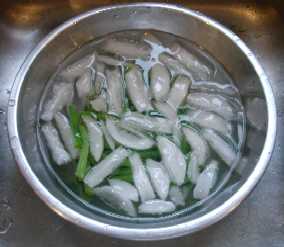 Cool
greens immediately in ice water. Drain the greens thoroughly (this
shouldn't take more than a minute).
Cool
greens immediately in ice water. Drain the greens thoroughly (this
shouldn't take more than a minute).
After vegetables are blanched, cool them quickly to prevent
overcooking. Plunge the greens into a large quantity of ice-cold water (I
keep adding more ice to it). A good rule of thumb: Cool for the same
amount of time as the blanch step. For instance, if you blanch greens for
3 minutes, then cool in ice water for at least 3 minutes.
Drain thoroughly.
Step 7 - Bag the greens
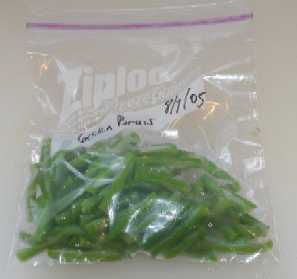 I
love the FoodSavers (see
this page for more information) with their vacuum sealing! I am
not paid by them, but these things really work. If you don't have
one, ziploc bags work, too, but it is hard to get as much air out of the
bags. remove the air to prevent drying and freezer burn. TIP:
If you don't own a vacuum food sealer to freeze foods, place food in a
Ziploc bags, zip the top shut but leave enough space to insert the tip of
a soda straw. When straw is in place, remove air by sucking the air out.
To remove straw, press straw closed where inserted and finish pressing the
bag closed as you remove straw.
I
love the FoodSavers (see
this page for more information) with their vacuum sealing! I am
not paid by them, but these things really work. If you don't have
one, ziploc bags work, too, but it is hard to get as much air out of the
bags. remove the air to prevent drying and freezer burn. TIP:
If you don't own a vacuum food sealer to freeze foods, place food in a
Ziploc bags, zip the top shut but leave enough space to insert the tip of
a soda straw. When straw is in place, remove air by sucking the air out.
To remove straw, press straw closed where inserted and finish pressing the
bag closed as you remove straw.
Step 8 - Done!
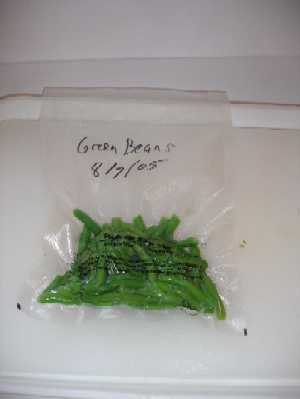 Pop
them into the freezer, on the quick freeze shelf, if you have one!
Pop
them into the freezer, on the quick freeze shelf, if you have one!
Freezing keeps greens safe to eat almost indefinitely, but the recommended
maximum storage time of 12 months is best for taste and quality. The quality of the
frozen greens is maintained best in a very cold freezer (deep freezer), and
one that keeps them frozen completely with no thaw cycles. Excluding any air
from inside the bags which leads to freezer burn, by using vacuum-sealed
bags, is also important to maintaining quality.
I love the FoodSavers (see
this page for more information) with their vacuum sealing! Here's an
example of one model:
FoodSaver V2840 Advanced Design
This one is the least expensive of the Food Saver models that has all the
advamced features, like automatic bag detection and sealing, which makes it
faster and easier to seal. And yes, you can seal and freeze foods with
liquids (just freeze the unsealed bag in the freezer overnight, THEN seal
it!)
About $135
 
Features
- Home vacuum-packaging system vacuums, seals, and shuts off
automatically
- Upright vacuum-sealing
appliance with SmartSeal technology keeps food fresh longer
-
Push-button operation;
built-in roll storage and cutter; automatic liquid detection
-
Crush-free instant seal;
2 vacuum speeds; 2 seal levels; progress lights; integrated
bag opener
-
Marinate and canister
modes; includes 3 quart-size bags, 2 gallon-size bags, and a
roll of bag material
-
Measures approximately 6
by 18-8/9 by 10-2/5 inches; 1-year limited warranty
|
Tips:
- Harvest early in the morning, especially if the weather is hot, to get
peak flavor.
- Harvest the greens at its peak maturity (firm, straight, not lumpy)
- Process promptly after harvesting, or keep cooled in the fridge or with
ice until then.
Frequently Asked Questions
- I've frozen greens but they seem so bland, starchy or rubbery after
being cooked. Any idea why?
Generally, that means the greens were either old to being with, or they were
overcooked. It only takes 2 or 3 minutes to blanch the greens, then plunge
them immediately into ice water.
- How long can they be frozen?
It depends upon how cold is your freezer and how you packed them. Colder
(deep freezes) are better than frost free compartments, which actually cycle
above freezing (that's how they melt the ice). Vacuum packing results in
longer storage capability, too. Thicker bags also help prevent freezer
burn.
In general, up to 9 months in a ziploc bag in an ordinary freezer, and 14
months in a deep freeze in a vacuum packed bag. After that, they greens
won't make you sick; they just won't taste a s good.

 Get
the pot of boiling water ready (about 2/3 filled) and a LARGE bowl with
ice and cold water.
Get
the pot of boiling water ready (about 2/3 filled) and a LARGE bowl with
ice and cold water. All
fruits and vegetables contain enzymes and bacteria
that, over time, break down the destroy nutrients and change the color,
flavor, and texture of food during frozen storage. greens requires a brief
heat treatment, called blanching, in boiling water or steam, to
destroy the enzymes before freezing. Blanching times for collards is 3
minutes and all other greens 2 minutes..
All
fruits and vegetables contain enzymes and bacteria
that, over time, break down the destroy nutrients and change the color,
flavor, and texture of food during frozen storage. greens requires a brief
heat treatment, called blanching, in boiling water or steam, to
destroy the enzymes before freezing. Blanching times for collards is 3
minutes and all other greens 2 minutes.. Cool
greens immediately in ice water. Drain the greens thoroughly (this
shouldn't take more than a minute).
Cool
greens immediately in ice water. Drain the greens thoroughly (this
shouldn't take more than a minute). I
love the FoodSavers (
I
love the FoodSavers ( Pop
them into the freezer, on the quick freeze shelf, if you have one!
Pop
them into the freezer, on the quick freeze shelf, if you have one!

